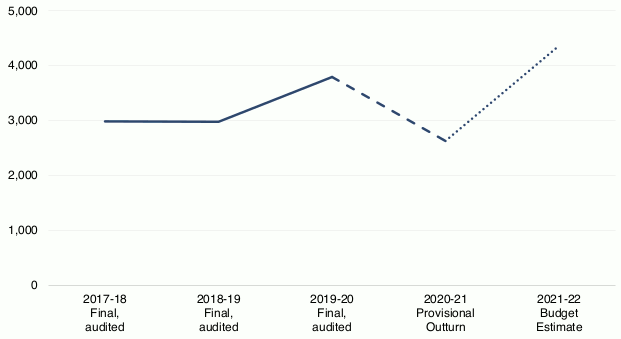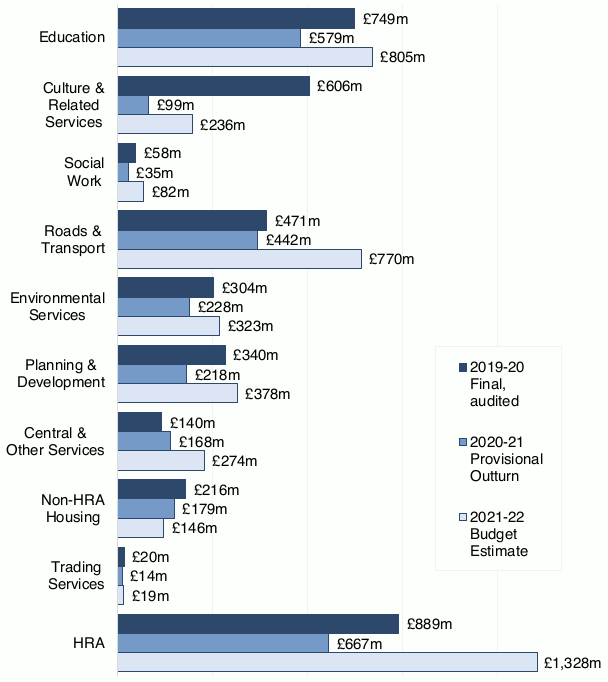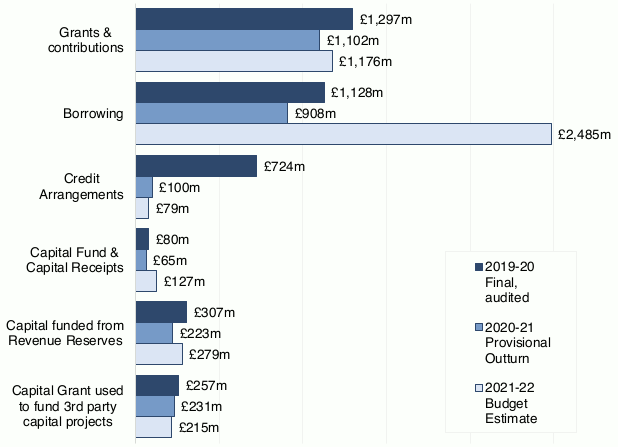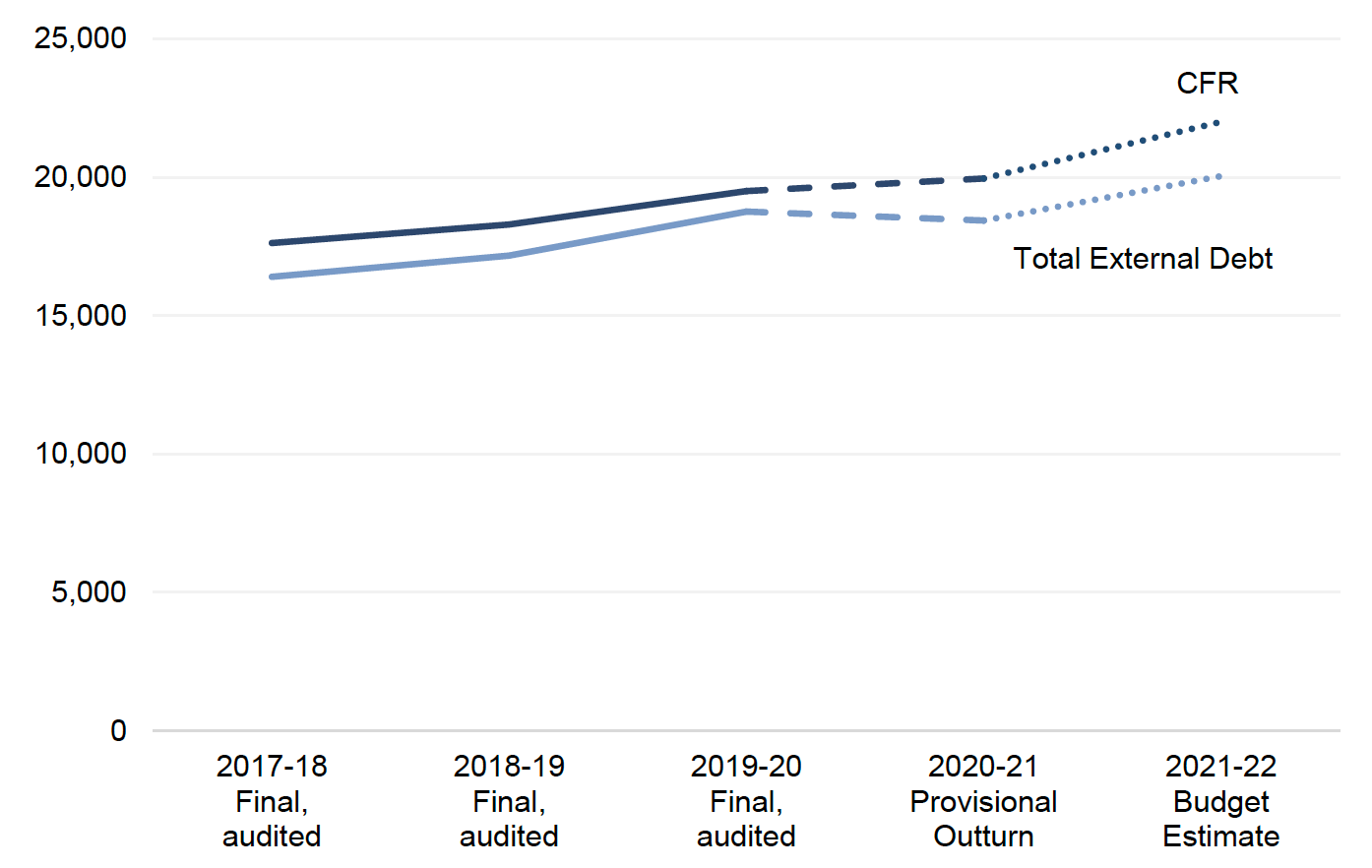Local Government 2020-21 Provisional Outturn and 2021-22 Budget Estimates
This publication summarises the 2020-21 provisional outturn and 2021-22 budget estimates for revenue and capital services provided by Scottish local authorities.
This document is part of a collection
Capital Expenditure
Capital expenditure is expenditure that creates an asset, extends the life of an asset or increases the value of an asset. It creates the buildings and infrastructure necessary to provide services, such as schools, care homes, flood defences, roads, vehicles, plant and machinery. Capital expenditure also includes grants a local authority provides to a third party to fund capital expenditure of the third party; direct expenditure on a third party’s assets; and loans to third parties to support capital investment of the third party where this is financed from capital resources.
It is important to note that the ‘lumpy’ nature of capital expenditure means that delays or changes to large capital projects at the end of the financial year can have a large impact on final, audited figures compared to provisional outturn and budgets.
For capital expenditure[3], local authorities have reported total provisional outturn of £2,629 million in 2020-21, and budget estimates of £4,361 million for 2021-22.

Source: POBE 2021 Return, LFR CR, CR Final
Whilst Figure 4 shows a notable decrease in capital expenditure between 2019-20 and 2020-21, it is important to note that the 2019-20 figure includes one-off sale and leaseback transactions by Glasgow City Council[4] accounting for approximately £450 million. It is likely that the remainder of this decrease is predominantly driven by the impacts of the Covid-19 pandemic on the building sector in 2020-21.
The majority of capital expenditure planned for, but not carried out in, 2020-21 will have been carried forward to the 2021-22 budgets and this will explain some of the significant increase seen in the budget estimates for capital expenditure.

Source: POBE 2021 Return, LFR CR, CR Final
Notes
‘Culture and Related Services’ figure for 2019-20 includes one-off sale and leaseback transactions for Glasgow City Council accounting for approximately £450 million.
'Roads & Transport' includes Road Bridges
‘Non-HRA Housing’ includes capital expenditure related to Consented and Statutory Borrowing
As shown in Figure 5, the largest area for capital expenditure relates to direct provision of housing by local authorities, with Housing Revenue Account (HRA) capital expenditure budgeted to double in 2021-22.
Most services show a reduction in capital expenditure in 2020-21 followed by a substantial increase budgeted in 2021-22, in line with the overall trend. Central and Other Services shows an increase in both years, partly due to investment in IT equipment and infrastructure. Capital expenditure on Non-HRA Housing decreases in both years, predominantly driven by a decrease in capital support to third parties.
Local authorities can finance capital expenditure in a number of ways, including use of grants[5] and contributions; borrowing; credit arrangements; capital receipts and reserves. Figure 6 shows how capital expenditure was financed in 2019-20 and how it is anticipated it will be financed in 2020-21 and 2021-22.

Source: POBE 2021 Return, LFR CR, CR Final
Notes
‘Borrowing’ includes borrowing used to fund grants to third party capital projects. This will be also counted under revenue income.
‘Credit Arrangements’ figure for 2019-20 includes one-off sale and leaseback transactions for Glasgow City Council accounting for approximately £450 million.
In both 2019-20 and 2020-21 the largest source of capital financing was grants and contributions, followed by borrowing. However, budget estimates for 2021-22 show a substantial planned increase in borrowing, making it the largest source of capital financing in 2021-22 at £2,485 million. This increase in borrowing is seen across most local authorities and is due to a combination of planned capital investment and reallocation of capital expenditure from 2020-21 as a result of the Covid-19 restrictions delaying capital projects in 2020-21.
The Chartered Institute of Public Finance and Accountancy (CIPFA) Prudential Code sets out a framework for a local authority to demonstrate its capital investment plans are affordable, prudent and sustainable. The Capital Financing Requirement (CFR) is one of the prudential indicators set out in this framework. It represents the amount of capital expenditure a local authority has determined should be met from borrowing or funded from a credit arrangement, with the repayment of debt met from future budgets. That is, it represents an authority’s underlying need to borrow money. Local authorities have reported total provisional CFR of £19,961 million in 2020-21, and total budget estimate for CFR of £22,009 million for 2021-22.
Total External Debt reflects local authorities’ gross external borrowing and other long-term liabilities. This may be less than the CFR where an authority has chosen to utilise cash reserves rather than borrow externally; or it may be more than the CFR where an authority has chosen to borrow in advance of capital expenditure being incurred[6]. Local authorities have reported total provisional external debt of £18,446 million in 2020-21, and total budget estimate for external debt of £20,041 million for 2021-22.
As shown in Figure 7 Total External Debt continues to remain below the CFR. This means local authorities are under-borrowed and indicates their treasury policy is to utilise cash reserves to fund borrowing at this time. Should their cash requirements increase, a local authority can borrow externally to meet that need, utilising their under-borrowed position.

Source: POBE 2021 Return, LFR CR, CR Final
Contact
Email: lgfstats@gov.scot
There is a problem
Thanks for your feedback